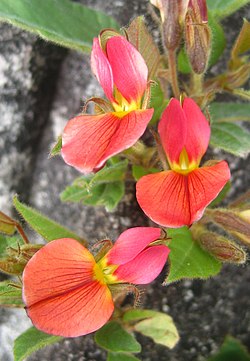| Rhynchosia | |
|---|---|
 | |
| Rhynchosia monophylla | |
| Scientific classification | |
| Kingdom: | Plantae |
| Clade: | Tracheophytes |
| Clade: | Angiosperms |
| Clade: | Eudicots |
| Clade: | Rosids |
| Order: | Fabales |
| Family: | Fabaceae |
| Subfamily: | Faboideae |
| Clade: | Millettioids |
| Tribe: | Phaseoleae |
| Subtribe: | Cajaninae |
| Genus: | Rhynchosia Lour. |
| Species [1] | |
260; see text | |
| Synonyms [1] | |
| |

Rhynchosia, also known as snoutbean, [3] is a genus of plants in the family Fabaceae. It includes 260 species of herbs, vines, and subshrubs native to tropical, subtropical, and warm temperate regions around the world, ranging from the southern United States to northern Argentina in the Americas, and through Africa, the Arabian Peninsula, southern Asia from Iran to Korea and Japan, New Guinea, and Australia. Typical habitats include seasonally-dry forest, forest margins, woodland, thicket, wooded grassland, shrubland, and grassland, often in open rocky areas, disturbed areas, or along streams. Many species are pyrophytes. [1] There are several different complexes within the genus, including the Senna complex. [4]